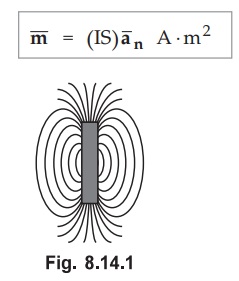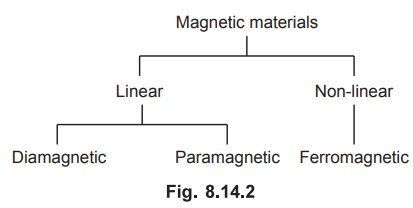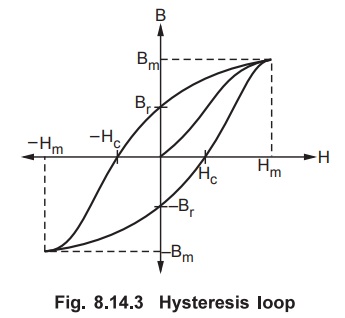Electromagnetic Theory: Unit III: (b) Magnetic Forces, Magnetic Materials and Inductance
Two Marks Questions with Answers
Magnetic Forces, Magnetic Materials and Inductance | Electromagnetic Theory
Electromagnetic Theory: Unit III: (b) Magnetic Forces, Magnetic Materials and Inductance : Two Marks Questions with Answers
Two Marks Questions with Answers
Q.1
What is meant by electric force ? Write expression of it.
Ans.
:
A force exerted on a static or moving charge Q by a static electric field is
known as an electric force. It is denoted by ![]() . The expression of an
electric force is given by,
. The expression of an
electric force is given by,

The
force ![]() is in the direction of
is in the direction of ![]() for a positive charge.
for a positive charge.
Q.2
Define magnetic force. Write its expression and significance.
Ans.
:
The force exerted on a charge Q moving with velocity ![]() in a steady
magnetic field
in a steady
magnetic field ![]() is called magnetic force. It is denoted by
is called magnetic force. It is denoted by ![]() .
It is given by,
.
It is given by,

From
above expression, it is clear that, the magnitude of the magnetic force depends
on magnitudes of Q,  and the sine of angle between
and the sine of angle between  . But
the direction of
. But
the direction of ![]() is perpendicular to the plane containing
is perpendicular to the plane containing  .
.
Q.3
What is Lorentz force equation ? Write its applications.
OR
What
is the total force acting on a moving charge, Q in the presence of both
electric and magnetic fields ?
OR
Write
Lorentz force equation for a moving charge.
AU
: May-09
Ans.
:
If a particle carrying charge + Q and moving with velocity ![]() is
present in a region where both electric and magnetic fields are present, then
the particle in a motion experiences forces
is
present in a region where both electric and magnetic fields are present, then
the particle in a motion experiences forces  due to the electric and
magnetic fields respectively and the resultant force experienced by a charged
particle in motion is given by,
due to the electric and
magnetic fields respectively and the resultant force experienced by a charged
particle in motion is given by,

Above
equation is called Lorentz Force Equation which relates mechanical force to the
electrical force.
The
solution of this equation is useful in the determination of electron orbits in
magnetron, proton paths in cyclotron and plasma characteristics in Magneto
Hydro Dynamic generator (MHD generator).
Q.4
What are the points of differences between electric force and magnetic force ?
Ans.
:

Q.5
Write an expression for force on a differential current element. What will be
expression for force on straight conductor in uniform magnetic field ?
AU
: Dec.18
Ans.
:
The force exerted on a differential current element is given by,

If
a conductor is straight and placed in the uniform magnetic field, the force
exerted is given by,

Q.6
A conductor 4 m long lies along the y-axis with the current of 10 A in ![]() direction, if the field is
direction, if the field is  . Tesla calculate the force on the
conductor.
. Tesla calculate the force on the
conductor.
Ans.
:

Q.7
Give an integral expression for the force on a closed circuit a current I in
the magnetic field H.
AU
: Dec.-04
Ans.
:
Refer answer of Q.5.
Q.8
Give an expression for the force between two current element.
Ans.
:
The force exerted on current element 1 due to current element 2 is given by,

Similarly
the force exerted on current element 2 due to current element 1 is given by,

Q.9
Write the expression for force between two parallel current carrying conductors. What will be the nature of force
depending upon direction of currents through the conductors ?
Ans.
:
In general the expression for force between two parallel current carrying
conductors is given by,
F
= (µ0 µr ) I1 I2 l / 2πd
where l = Length of conductor,
I1
I2 = Current through
conductors
d
= Distance of separation between conductors
Observations
:
When currents through conductors are in same direction, then conductors
experience force of attraction. When the currents through conductors are
opposite in direction, the conductors experience force of repulsion.
Q.10
Two wires carrying currents of 2 A and 3 A in opposite direction with 5 cm
apart from each other in free space. Calculate force between then state nature
of force.
Ans
. : F
= µ I1 I2 l / 2πd
As
length is not mentioned, the force should be calculated per length as follows.


As
the currents are in same direction, the force experienced will be force of
attraction.
Q.11 What is meant by magnetic moment?
OR
Define
magnetic moment. AU: May-04
OR
Define
torque.
Ans.
:
The moment of force or torque about a specified point is defined as the vector
product of the moment arm ![]() and the force
and the force ![]() . The torque is
measured in N.m in Nm (i.e. newton meter). Th mathematical expression is given
by,
. The torque is
measured in N.m in Nm (i.e. newton meter). Th mathematical expression is given
by,

Q.12
Define magnetic dipole moment. Sketch the field due to magnetic dipole.
OR
What
is magnetic dipole moment?
AU:
Dec.-03
Ans.
:
The magnetic dipole moment of a current loop is defined as the product of
current through the loop and the area of the loop, directed normal to the
current loop. From the definition it is clear that, the magnetic dipole moment
is a vector quantity. It is denoted by ![]() . The direction of the
magnetic dipole moment
. The direction of the
magnetic dipole moment ![]() is given by the right hand
thumb rule. The right hand thumb indicates the direction of the unit vector in
which
is given by the right hand
thumb rule. The right hand thumb indicates the direction of the unit vector in
which ![]() is directed and the figures represents the current
direction. The magnetic dipole moment is given by,
is directed and the figures represents the current
direction. The magnetic dipole moment is given by,

Q.13
For 500 turn rectangular coil, 15 cm by 7.5 cm in dimension, current of 5 A
flows through it. It is placed in uniform field of B = 0.1 T. Determine
magnetic dipole moment and maximum torque.
Ans.
:
For a single turn of a rectangular coil, area is given by,
S'
(15 × 10-2) (7.5 × 10-2) = 0.01125 m2
For
500 turn rectangular coil, total area is given by,
S
= NS' (500) (0.01125) = 5.625m2
The
magnitude of the magnetic moment is given by,
m
= (I) (5) = (5) (5.625) = 28.125 Am2
The
magnitude of maximum torque is given by,
Tmax
= mB = (28.125) (0.1) = 2.8125 Nm
Q.14
Classify the magnetic materials.
OR
Name
magnetic materials.
Ans.
:

The
material with relative permeability µr ≤ 1, it is called
diamagnetic.
The
material with relative permeability µr ≥ 1, is called paramagnetic.
The
material with relative permeability µr >> 1 is called
ferromagnetic.
Q.15
Define diamagnetic, paramagnetic and ferromagnetic material.
Ans.
:
The magnetic materials in which the orbital magnetic moment and electron spin
magnetic moment cancel each other making net permanent magnetic moment of each
atom zero are called diamagnetic materials.
The
magnetic materials in which the orbital and spin magnetic moments do not cancel
each other resulting in a net magnetic moment of an atom are called
paramagnetic materials.
The
materials in which the atoms have large dipole moment due to electron spin
magnetic moments are called ferromagnetic materials.
Q.16
Define hysteresis.
OR
What
is meant by hysteresis ? Draw hysteresis
OR
Explain
the phenomenon of hysteresis with reference to ferromagnetic materials.
Draw
B-H curve classifying magnetic materials.
Ans.
:
In the ferromagnetic materials, the adjacent atoms line up their magnetic
dipole moments in parallel fashion in the lattice. The regions in which large
number of magnetic moments lined in parallel are called domains. When an
external field is applied, the domains increase their size increasing internal
field to a high value. When the external field is removed, the original random
alignment of dipole moments is not achieved. Some of the moments remain in a
small region which results in residual field or remanant field. This effect is
called hysteresis. Iron, nickel and cobalt are the examples of ferromagnetic
materials.

Q.17
What is meant by soft and hard magnetic materials ?
Ans.
:
The magnetic material which retains high residual flux density is called hard
magnetic material. The material with small values of the residual flux density
is called soft material.
Q.18
Explain antiferromagnetic material.
Ans.
:
The materials in which the dipole moments of adjacent atoms line up in
antiparallel fashion are called antiferromagnetic materials. The net magnetic
moment in such materials is zero. Thus when a specimen of antiferromagnetic
material is kept near a strong magnet gets neither attracted nor repelled. This
property is observed in materials like many of the oxides, chlorides and sulphides
at low temperatures.
Q.19
What is meant by ferrimagnetic materials and ferrites ?
Ans.
:
The materials in which the magnetic dipole moments are lined up in antiparallel
fashion, but the net magnetic moment is non-zero are called ferrimagnetic
materials. Ferrites are special ferrimagnetic materials having very low
electrical conductivity.
Q.20
Explain supermagnetic materials.
Ans.
:
In supermagnetic materials, the ferromagnetic materials are suspended in the
dielectric matrix. The important property of the supermagnetic material is that
eventhough each particle of it contain large magnetic domains but can not
penetrate adjacent particles. The common examples of supermagnetic materials are
magnetic tapes used for audio, video and data recordings.
Q.21
Define magnetization.
Ans.
:
The field produced due to movement of bound charges is called magnetization
represented by ![]() . The magnetization is defined as the magnetic dipole
moment per unit volume. Its unit is A/m.
. The magnetization is defined as the magnetic dipole
moment per unit volume. Its unit is A/m.

Q.22
What is magnetic susceptibility ?
Ans.
: The ratio of magnetization M to the magnetic field intensity H is called
magnetic susceptibility. It is denoted by Xm. It is the measure of
how susceptible the material is to the magnetic field. By definition  where Xm is dimensionless.
where Xm is dimensionless.
Q.23
What is relative permeability of material ?
AU
: Dec.-04
Ans.
:
The ratio of permeability (µ) of a material to the permeability (µ0)
of free space is called relative permeability of material. It is denoted by µr.
It is a dimensionless quantity. Mathematically it can be expressed as,
µr
= µ / µ0 = (1 + Xm)
Q.24
What is the relationship between magnetic flux density, magnetic field
intensity and magnetization ?
Ans.
:
The relationship between magnetic flux density ![]() , magnetic field
intensity
, magnetic field
intensity ![]() and magnetization
and magnetization ![]() is given by,
is given by,

Q.25
State the boundary conditions of magnetic media.
AU
: Dec.-09
OR
Write
magnetic boundary conditions.
AU
: Dec.-13, May-16
Ans.
: 1)
The normal component of magnetic flux density ![]() is continuous at boundary
between two magnetic media, i.e. Btan 1 / Btan 2 = µ1
/ µ2
is continuous at boundary
between two magnetic media, i.e. Btan 1 / Btan 2 = µ1
/ µ2
2)
The tangential component of magnetic field intensity ![]() is continuous
at the boundary between two magnetic media, i.e.
is continuous
at the boundary between two magnetic media, i.e.
HN1
= HN2 = µ2 / µ1
Q.26
Define self inductance.
AU
: May-03, 05,15, Dec.-04, 17
Ans.
:
The ratio of total flux linkage to the current producing that flux is called
inductance denoted by L. It is measured in henry (H).
L
= (N ϕ
/ I) H
Q.27
Define mutual inductance.
AU
; May-03, 05, 09, 15,Dec.-04
Ans.
:
With respect to the flux linkage, the mutual inductance between the two coils
is defined as the ratio of flux linkage of one coil to the current in other
coil. Hence we can write,

Q.28
Determine the force per meter length between two long parallel wires A and B
separated bp 5 mm in air and each carrying current of 40 A in the same
direction.
Ans.
:
Force between two parallel conductors is given by,

Hence
force per meter length is given by,

Both
conductors carry equal current so I1 = I2 =40 A. The
distance between two conductors is d = 5 mm = 5 × l0-3m.
Substituting values, we get,

Q.29
A loop with magnetic dipole moment  lies
in a uniform magnetic field of
lies
in a uniform magnetic field of  Calculate torque.
Calculate torque.
AU
: May-11
Ans.
:
Torque is given by,

Q.30
What is the force and its direction on a conductor in + z-axis carrying current
I and placed in a magnetic filed ![]() along X-axis ?
along X-axis ?
Ans.
:
In general, force on a conductor is given by,

Thus
the force will be directed in + y direction.
Q.31
What is the expression for the torque experienced by a current carrying loop,
placed in magnetic field ?
AU
: May-03, 06
Ans.
The
torque experienced by a current carrying loop placed in a magnetic filed is
given by,

Q.32
Find the maximum torque on an 100 turns rectangular coil of 0.2 m by 0.3 m,
carrying current of 2 A in the field of flux density 5 Web/m2.
AU
: May-15
Ans.
Area
of single turn rectangular coil is given by,
S1
= (0.2)(0.3) = 0.06 m2
For
100 turn rectangular coil, total area will be,
S
= NS1 = (100) (0.06) = 6m2
Hence
magnitude of maximum torque on rectangular coil is given by,
T
= mB = ISB = (2)(6)(5) = 60 Nm
Q.
33 What is the expression for inductance of a toroid ?
Ans.
The
inductance of a toroid is given by,
L
= µN2 A / 2 π R
where A = Area of corss-section of a troidal ring
R
= Radius of a toroid.
N
= Number of turns.
Q.
34 A solenoid 3 cm in length carries a current of 200 mA. If solenoid is to
produce a magnetic flux density of 4.6 mWb/m2 , how many turns of
wire are needed ?
AU
: May-11
Ans.
: The
field intensity inside solenoid is given by,

Q.35
State Ohm’s law for magnetic circuits.
Ans.
: For
magnetic circuits, Ohm's law is given by,
m.m.f.
= Magnetomotive force
=
ϕ R where ϕ is total flux and R is reluctance of circuit.
Q.36
Find inductance per unit length of long solenoid of N turns and having length I
meters. Assume that it carries current of I amperes.
Ans.
:
Let I be the length of solenoid. Then inductance
of a solenoid of N terms carrying current I is given by,
L
= ( µN2 A / l ) H
Hence
the inductance per unit length is given by,
L
= L / l ( µN2 A / l 2) H/m
Q.37
What is the mutual inductance of the two inductively coupled coils with self
inductance of 25 mH and 100 mH ?
AU
: Dec.-15
Ans.
:
The mutual inductance is given by,
M
= k √L1L2
where
k is coefficient of coupling
M
= k√ (25 × 10-3)(100 × 10-3) = (50 × 10-3)k H
...
answer interms of k.
Assuming
two coils tightly coupled i.e. k = 1, then M = 50 mH.
Q.38
Define reluctance and permeability.
Ans.
:
The resistance offered by the material to the flow of magnetic flux through it,
is called reluctance.
The
ability or case with which the magnetic material forces the magnetic flux
through a given medium is called the permeability of that medium.
Q.39
Write down the steps to calculate inductance of various shapes.
Ans.
:
Assume current I flowing. From this, calculate the magnetic field strength H.
For the given medium, find B from the relation B = µH Find the flux from
cross-sectional area of the shape A as ϕ = BA. Then find the flux linkages Nϕ Then
dividing flux linkages by the current, the inductance can be obtained.
Q.40
What is main effect of eddy current ?
AU
: May-19
Ans.
: The
eddy currents are induced currents in a conductor due to changing magnetic
fields. These currents flow in closed loops, in planes perpendicular to the
magnetic field. The main effect of these currents is to produce losses causing
heat as these currents oppose the change in the magnetic field which created
it. These losses reduce efficiency of machines while heat produced can be used
for induction heating.
Q.
41 What is energy density in magnetic field ?
AU
: Dec.-19
Ans
. :
Energy density in magnetic field = 1 / 2
B2 / µ
=
1/2 µH2 J/m3
Electromagnetic Theory: Unit III: (b) Magnetic Forces, Magnetic Materials and Inductance : Tag: : Magnetic Forces, Magnetic Materials and Inductance | Electromagnetic Theory - Two Marks Questions with Answers
Related Topics
Related Subjects
Electromagnetic Theory
EE3301 3rd Semester EEE Dept | 2021 Regulation | 3rd Semester EEE Dept 2021 Regulation
